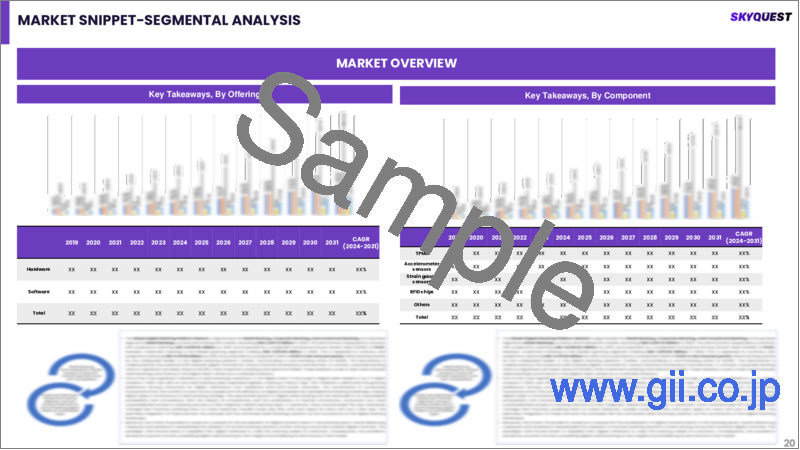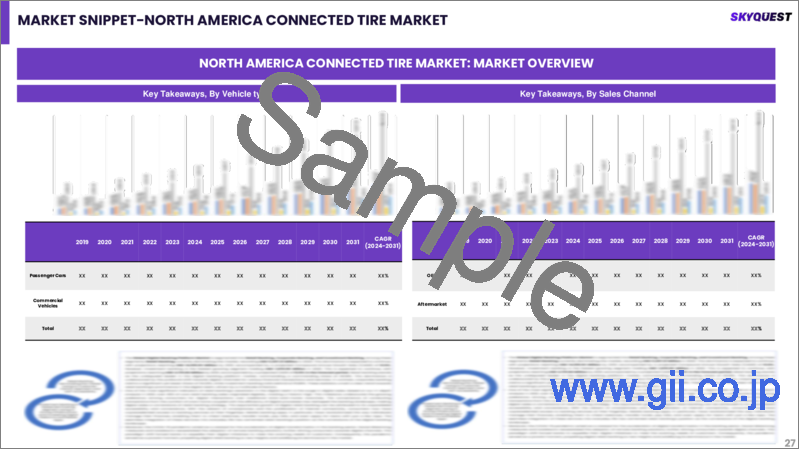|
|
市場調査レポート
商品コード
1510381
コネクテッドタイヤの市場規模、シェア、成長分析、リムサイズ別、推進力別、オファリング別、コンポーネント別、車両タイプ別、販売チャネル別、地域別 - 産業予測、2024年~2031年Connected Tire Market Size, Share, Growth Analysis, By Rim size, By Propulsion, By Offering, By Component, By Vehicle type, By Sales Channel, By Region - Industry Forecast 2024-2031 |
||||||
|
|||||||
| コネクテッドタイヤの市場規模、シェア、成長分析、リムサイズ別、推進力別、オファリング別、コンポーネント別、車両タイプ別、販売チャネル別、地域別 - 産業予測、2024年~2031年 |
|
出版日: 2024年07月05日
発行: SkyQuest
ページ情報: 英文 223 Pages
納期: 3~5営業日
|
- 全表示
- 概要
- 目次
コネクテッドタイヤの市場規模は、2022年に60億米ドルとなり、予測期間中(2024年~2031年)のCAGRは45%で、2023年の87億米ドルから、2031年までには1,700億1,000万米ドルに成長すると予測されています。
コネクテッドタイヤ市場は、自動車メーカーや自動車分野のテクノロジー企業による継続的なイノベーションによって大きな成長を遂げています。センサーと通信機能を備えたこれらのコネクテッドタイヤは、タイヤの状態、性能、安全性に関するデータをリアルタイムで提供することで、運転体験に革命をもたらしています。この技術的進歩により、ドライバーはより優れた車両制御、強化された安全機能、より効率的なメンテナンス方法を手に入れることができます。さらに、持続可能性と環境への配慮が重視されるようになり、燃費の向上と二酸化炭素排出量の削減に貢献するコネクテッドタイヤの採用が加速しています。スマートで相互接続された自動車に対する消費者の需要が高まる中、コネクテッドタイヤ市場は今後数年間でさらに拡大する見通しです。
目次
イントロダクション
- 調査の目的
- 定義
- 市場範囲
調査手法
- 情報調達
- 二次・一次情報源
- 市場規模予測
- 市場の前提条件と制限
エグゼクティブサマリー
- 市場概要見通し
- 供給需要動向分析
- セグメント別機会分析
市場力学と見通し
- 市場力学
- 促進要因
- 機会
- 抑制要因
- 課題
- ポーターの分析
主要な市場の考察
- バリューチェーン分析
- 価格分析
- スタートアップ分析
- 主要な成功要因
- 市場の魅力指数
- 競合の程度
- 主要な投資機会
- エコシステムマッピング
コネクテッドタイヤ市場:リムサイズ別
- 市場概要
- 12~17インチ
- 18~22インチ
- 22インチ以上
コネクテッドタイヤ市場:推進力別
- 市場概要
- 電気
- ICエンジン
コネクテッドタイヤ市場:オファリング別
- 市場概要
- ソフトウェア
- ハードウェア
コネクテッドタイヤ市場:コンポーネント別
- 市場概要
- 加速度計
- 歪みゲージ
- RFIDチップ
- TPMS
コネクテッドタイヤ市場:車両タイプ別
- 市場概要
- 乗用車
- 商用車
コネクテッドタイヤ市場:販売チャネル別
- 市場概要
- アフターマーケット
- メーカー
コネクテッドタイヤ市場規模:地域別
- 市場概要
- 北米
- 米国
- カナダ
- 欧州
- ドイツ
- スペイン
- フランス
- 英国
- イタリア
- その他欧州地域
- アジア太平洋
- 中国
- インド
- 日本
- 韓国
- その他アジア太平洋
- ラテンアメリカ
- ブラジル
- その他ラテンアメリカ地域
- 中東・アフリカ(MEA)
- GCC諸国
- 南アフリカ
- その他中東・アフリカ地域
競合情勢
- 上位5社の比較
- 主要企業の市場ポジショニング(2023年)
- 主要な市場企業が採用した戦略
- 市場における最近の活動
- 主要企業の市場シェア(2023年)
主要企業プロファイル
- Continental AG(Germany)
- Michelin(France)
- Bridgestone Corporation(Japan)
- The Goodyear Tire & Rubber Company(US)
- Pirelli & C. S.p.A.(Italy)
- Nokian Tyres plc(Finland)
- Sumitomo Rubber Industries Ltd.(Japan)
- Hankook Tire & Technology Co., Ltd.(South Korea)
- Yokohama Rubber Co., Ltd.(Japan)
- Toyo Tire Corporation(Japan)
- Cooper Tire & Rubber Company(US)
- Kumho Tire Co., Inc.(South Korea)
- Giti Tire(Singapore)
- Apollo Tyres Ltd.(India)
- MRF Ltd.(India)
Connected Tire Market size was valued at USD 6 Billion in 2022 and is poised to grow from USD 8.7 Billion in 2023 to USD 170.01 Billion by 2031, at a CAGR of 45% during the forecast period (2024-2031).
The connected tire market is witnessing significant growth driven by ongoing innovations from automakers and technology firms within the automotive sector. These connected tires, equipped with sensors and communication capabilities, are revolutionizing the driving experience by delivering real-time data on tire condition, performance, and safety. This technological advancement empowers drivers with greater vehicle control, enhanced safety features, and more efficient maintenance practices. Moreover, the increasing emphasis on sustainability and environmental considerations is fueling the adoption of connected tires, which contribute to improved fuel efficiency and reduced carbon emissions. With rising consumer demand for smart and interconnected vehicles, the connected tire market is poised for further expansion in the upcoming years.
Top-down and bottom-up approaches were used to estimate and validate the size of the Connected Tire market and to estimate the size of various other dependent submarkets. The research methodology used to estimate the market size includes the following details: The key players in the market were identified through secondary research, and their market shares in the respective regions were determined through primary and secondary research. This entire procedure includes the study of the annual and financial reports of the top market players and extensive interviews for key insights from industry leaders such as CEOs, VPs, directors, and marketing executives. All percentage shares split, and breakdowns were determined using secondary sources and verified through Primary sources. All possible parameters that affect the markets covered in this research study have been accounted for, viewed in extensive detail, verified through primary research, and analyzed to get the final quantitative and qualitative data.
Connected Tire Market Segmental Analysis
Connected tire market is segmented based on rim size, propulsion, offering, component, vehicle type, sales channel, and region. Based on rim size the market is segmented as 12 - 17 Inches, 18 - 22 Inches, and More Than 22 Inches. Based on propulsion, the market is segmented into Electric, and IC Engine. Based on offering, the market is segmented into software, and hardware. Based on component, the market is segmented into Accelerometer, Strain Gauge, RFID Chip, and TPMS. Based on vehicle type, the market is segmented into Passenger Cars, and Commercial Vehicle. Based on the sales channel, the market is segmented into Aftermarket, and OEM. Based on region, the market is segmented into North America, Europe, Asia Pacific, Middle East and Africa, and Latin America.
Drivers of the Connected Tire Market
An important factor propelling the connected tire market is the growing focus on safety and efficiency within the automotive sector. Connected tires offer real-time information about tire conditions, facilitating proactive maintenance and lowering the likelihood of accidents caused by tire-related issues. Moreover, they enhance fuel efficiency and help reduce emissions, which resonates with the increasing environmental awareness among consumers and regulatory agencies.
Restraints in the Connected Tire Market
One notable obstacle to the adoption of connected tires is the substantial initial costs linked to these advanced technologies. The installation of sensors and communication systems within tires can incur high expenses, potentially discouraging certain consumers and fleet operators from adopting connected tire solutions. Despite the significant long-term advantages in terms of safety and efficiency, the upfront investment presents a significant hurdle for achieving widespread adoption.
Market Trends of the Connected Tire Market
With the advent of self-driving cars, there is an increasing need for sophisticated sensor-based tire monitoring systems capable of seamless communication with autonomous vehicle control systems. These connected tire solutions not only improve safety by delivering real-time tire condition data but also play a pivotal role in optimizing the performance and safety of autonomous vehicles. This aligns with the broader trend towards autonomous transportation.
Table of Contents
Introduction
- Objectives of the Study
- Definitions
- Market Scope
Research Methodology
- Information Procurement
- Secondary & Primary Data Sources
- Market Size Estimation
- Market Assumptions & Limitations
Executive Summary
- Market Overview Outlook
- Supply Demand Trend Analysis
- Segmental Opportunity Analysis
Market Dynamics & Outlook
- Market Dynamics
- Drivers
- Opportunities
- Restraints
- Challenges
- Porters Analysis
- Competitive rivalry
- Threat of Substitute Products
- Bargaining Power of Buyers
- Threat of New Entrants
- Bargaining Power of Suppliers
Key Market Insights
- Value Chain Analysis
- Pricing Analysis
- Start Up Analysis
- Key Success Factors
- Market Attractiveness Index
- Degree of Competition
- Top Investment Pockets
- Ecosystem Mapping
Connected Tire Market by Rim Size
- Market Overview
- 12 - 17 Inches
- 18 - 22 Inches
- More Than 22 Inches
Connected Tire Market by Propulsion
- Market Overview
- Electric
- IC Engine
Connected Tire Market by Offering
- Market Overview
- Software
- Hardware
Connected Tire Market by Component
- Market Overview
- Accelerometer
- Strain Gauge
- RFID Chip
- TPMS
Connected Tire Market by Vehicle Type
- Market Overview
- Passenger Cars
- Commercial Vehicle
Connected Tire Market by Sales Channel
- Market Overview
- Aftermarket
- OEM
Connected Tire Market Size by Region
- Market Overview
- North America
- USA
- Canada
- Europe
- Germany
- Spain
- France
- UK
- Italy
- Rest of Europe
- Asia Pacific
- China
- India
- Japan
- South Korea
- Rest of Asia-Pacific
- Latin America
- Brazil
- Rest of Latin America
- Middle East & Africa (MEA)
- GCC Countries
- South Africa
- Rest of MEA
Competitive Landscape
- Top 5 Player Comparison
- Market Positioning of Key Players, 2023
- Strategies Adopted by Key Market Players
- Recent Activities in the Market
- Key Companies Market Share (%), 2023
Key Company Profiles
- Continental AG (Germany)
- Company Overview
- Business Segment Overview
- Financial Updates
- Key Developments
- Michelin (France)
- Company Overview
- Business Segment Overview
- Financial Updates
- Key Developments
- Bridgestone Corporation (Japan)
- Company Overview
- Business Segment Overview
- Financial Updates
- Key Developments
- The Goodyear Tire & Rubber Company (US)
- Company Overview
- Business Segment Overview
- Financial Updates
- Key Developments
- Pirelli & C. S.p.A. (Italy)
- Company Overview
- Business Segment Overview
- Financial Updates
- Key Developments
- Nokian Tyres plc (Finland)
- Company Overview
- Business Segment Overview
- Financial Updates
- Key Developments
- Sumitomo Rubber Industries Ltd. (Japan)
- Company Overview
- Business Segment Overview
- Financial Updates
- Key Developments
- Hankook Tire & Technology Co., Ltd. (South Korea)
- Company Overview
- Business Segment Overview
- Financial Updates
- Key Developments
- Yokohama Rubber Co., Ltd. (Japan)
- Company Overview
- Business Segment Overview
- Financial Updates
- Key Developments
- Toyo Tire Corporation (Japan)
- Company Overview
- Business Segment Overview
- Financial Updates
- Key Developments
- Cooper Tire & Rubber Company (US)
- Company Overview
- Business Segment Overview
- Financial Updates
- Key Developments
- Kumho Tire Co., Inc. (South Korea)
- Company Overview
- Business Segment Overview
- Financial Updates
- Key Developments
- Giti Tire (Singapore)
- Company Overview
- Business Segment Overview
- Financial Updates
- Key Developments
- Apollo Tyres Ltd. (India)
- Company Overview
- Business Segment Overview
- Financial Updates
- Key Developments
- MRF Ltd. (India)
- Company Overview
- Business Segment Overview
- Financial Updates
- Key Developments





